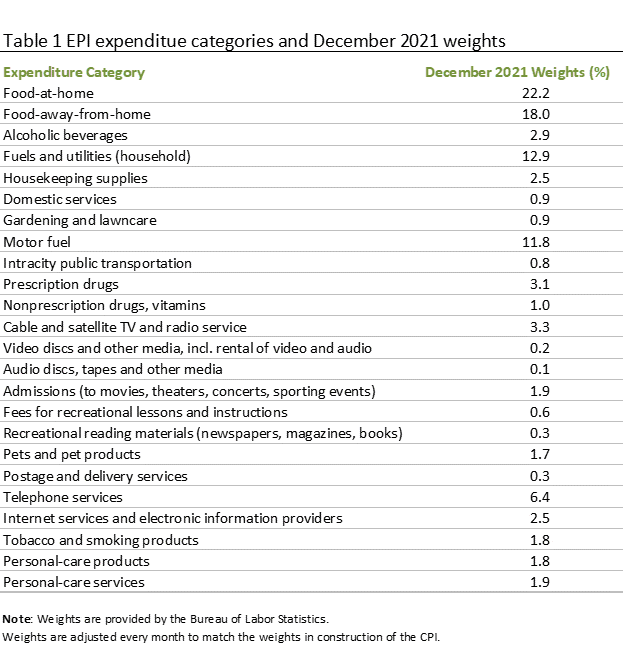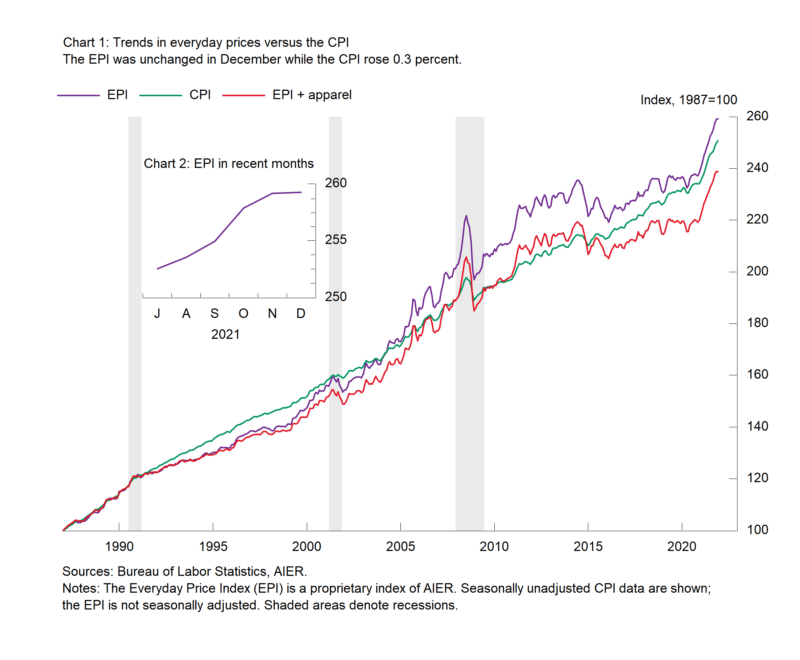Drop in Gas Holds AIER’s Everyday Price Index Down in December
Motor fuel prices fell 2.1 percent in December, offsetting gains in food prices (both food at home and food away from home), leaving the AIER Everyday Price unchanged in December. This follows a string of 12 consecutive monthly increases that ranged from 0.4 percent to 1.2 percent per month. From a year ago, the Everyday Price Index is up 8.8 percent, slower than the 9.3 percent gain for the 12 months ending in November but still among the highest ever for the Everyday Price Index.
Gains were more mixed than in recent months with 13 of the 24 components making a positive contribution for the month versus an average of 18 over the last five months. Most of the changes were small for the month outside of motor fuel, food at home, and food away from home.
Motor fuel fell 2.1 percent for the month, subtracting 25 basis points from the monthly gain. Food away from home (a.k.a. restaurants) was the largest contributor in December, adding 11 basis points while food at home (a.k.a. groceries) added 10 basis points. Household fuels and utilities rose in December but added just 2 basis points. Combined, food and energy categories have a weighting of 65.0 percent of the Everyday Price Index. Other categories with gains in December included housekeeping supplies, domestic services, and personal care services while decliners included cable and satellite television service and admissions to movies, theaters, concerts, sporting events.
The Everyday Price Index including apparel, a broader measure that includes clothing and shoes, was also unchanged for the month. Over the past year, the Everyday Price Index including apparel is up 8.6 percent, down from a 12-month gain of 9.0 percent in November. Apparel prices fell 1.1 percent on a not-seasonally-adjusted basis in December. Apparel prices tend to be volatile on a month-to-month basis. From a year ago, apparel prices are up 5.8 percent.
The Consumer Price Index, which includes everyday purchases as well as infrequently purchased, big-ticket items and contractually fixed items, rose 0.3 percent on a not-seasonally-adjusted basis in December. Over the past year, the Consumer Price Index is up 7.0 percent, significantly less than the 8.8 percent rise in the EPI.
The Consumer Price Index excluding food and energy rose 0.4 percent for the month (not seasonally adjusted) while the 12-month change came in at 5.5 percent. The 12-month change in the core CPI was just 1.3 percent in February 2021 and 2.4 percent in February 2020, before the pandemic.
After seasonal adjustment, the CPI rose 0.5 percent in December while the core increased 0.6 percent for the month. Within the core, core goods prices were up 1.2 percent in December and are up 10.7 percent from a year ago while core services prices were up 0.3 percent for the month and are up 3.7 percent from a year ago.
Among the notable increases in the core goods category were used cars and trucks (up 3.5 percent and 37.3 percent from a year ago), furniture and bedding (up 2.0 percent and 13.8 percent from a year ago), new vehicles (up 1.0 percent and 11.8 percent from a year ago), appliances (up 1.1 percent and 6.0 percent from a year ago), and tobacco products (up 0.7 percent and 9.0 percent from a year ago). Apparel prices rose 1.7 percent after seasonal adjustment despite a 1.1 percent decline on a not-seasonally-adjusted basis.
Among core services, gainers include lodging away from home (up 1.2 percent and 23.9 percent from a year ago), owners’ equivalent rent (which accounts for 23.5 percent of the CPI, rose 0.4 percent for the month and 3.8 percent from a year ago), air fares (up 2.7 percent but only 1.4 percent from a year ago), and health insurance (up 1.6 percent for the month but still down 1.2 percent from a year ago). Notably, car and truck rentals, among the fastest gainers during the early part of the pandemic, were down 5.3 percent for the month, but are still up 36.0 percent for the year.
Price pressures for many goods and services in the economy remain elevated due to shortages of supplies and materials, logistical and supply chain issues, and labor problems. As activity returns to normal, supply and demand will adjust and likely lead to slower price increases, but it may take some time before the economy completely returns to normal functioning. Recurring waves of new Covid cases will likely prolong the process.
Note: The Everyday Price Index for November is based on incomplete data due to restrictions on data collection by Bureau of Labor Statistics personnel because of the Covid-19 pandemic.







